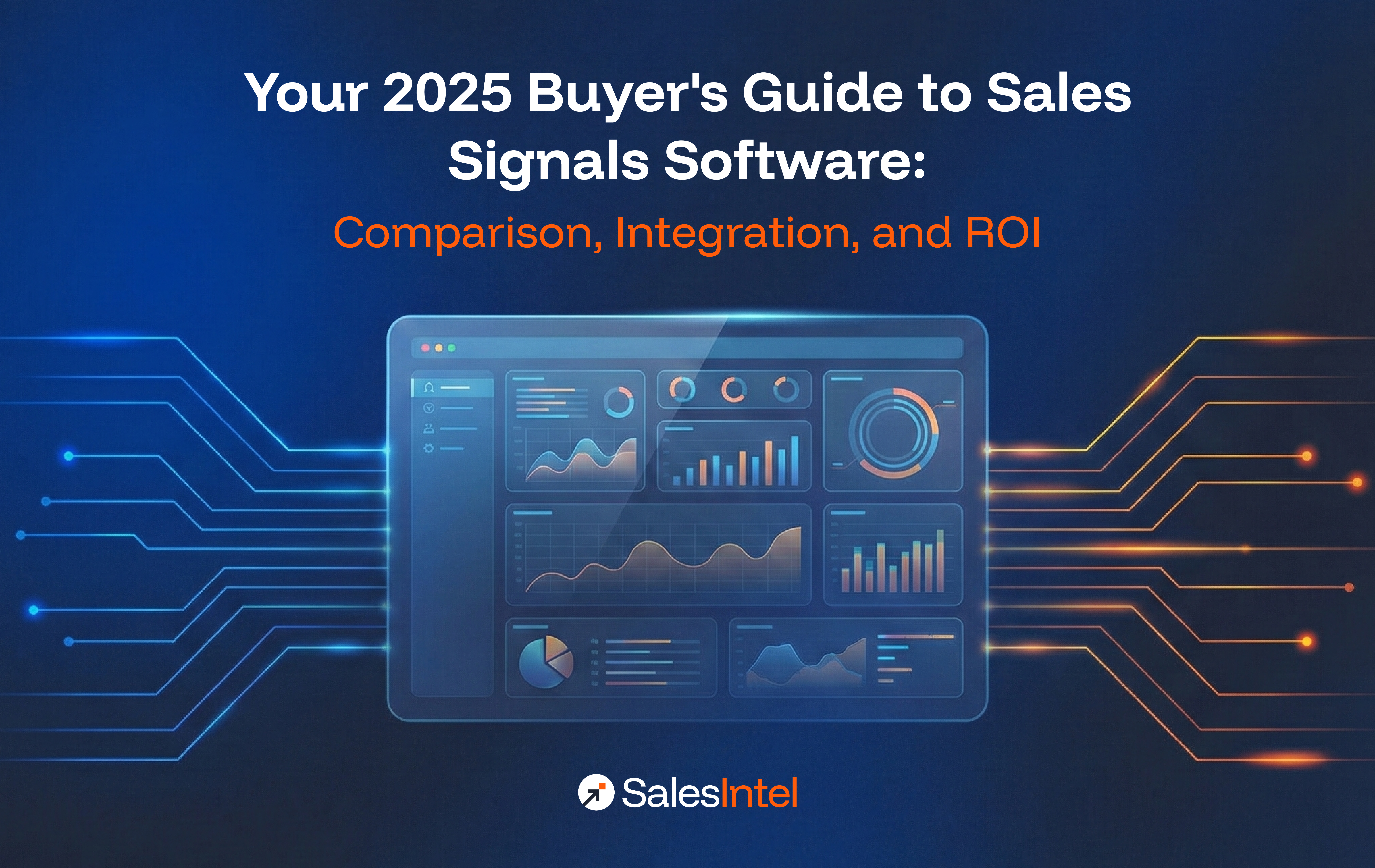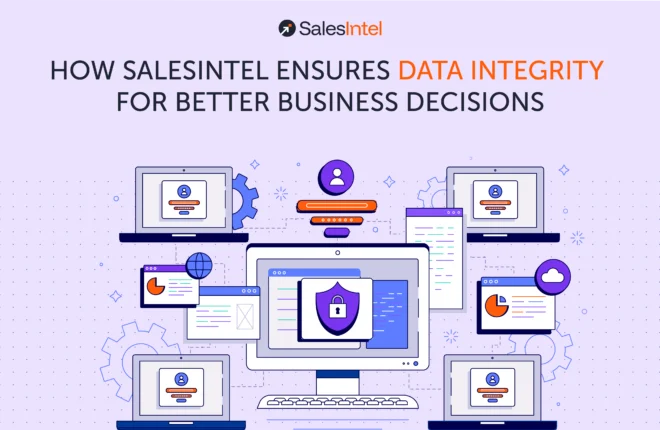In the field of B2B, sales success is dependent on understanding the B2B buyer’ss decision-making process. Using a buyer’s journey map and matching sales strategies can help you build lasting relationships and close deals.
This article will explore the critical stages of the B2B consumer online decision-making process, offering sales professionals valuable insights.
The B2B purchasing process is vastly different from the online impulsive consumer decisions that we make as individuals. In general, B2B purchases necessitate a rigorous evaluation process, extensive research, and the involvement of multiple stakeholders.
In contrast to the B2C market, where emotions frequently play a role, rational factors like cost, quality, and ROI dominate B2B decision-making. Businesses must justify their investments and ensure they meet strategic goals, making the buying cycle longer and more complicated.
The following key players have an impact on online B2B purchasing decisions:
Decision-Makers
These are the individuals who possess the power to approve or reject a purchase. They are typically high-level executives or department heads who are accountable for ensuring that the purchase is consistent with the company’s objectives.
Influencers
The individuals who offer suggestions and input but may not possess the final decision-making authority. Purchasing decisions are made with consideration for their opinions and expertise. To effectively navigate the B2B purchasing process, it is crucial for sellers to identify and engage with both decision-makers and influencers.
Gatekeepers
Individuals who have the ability to access decision-makers. Gatekeepers can help or hinder the sales process, so sellers must build relationships with them to reach key decision-makers. It is imperative to comprehend the function of gatekeepers and influencers in order to effectively conclude B2B transactions.
Users
The individuals who will ultimately use the product or service. When presenting their products or services, sellers should also take into account the needs and preferences of the users, as their satisfaction can significantly influence the success of the sale. Sellers can improve their chances of closing deals by tailoring their approach to each stakeholder’s needs and understanding all parties’ perspectives.
Identifying the Problem: The First Stage in the B2B Journey
The B2B buying process begins with identifying a problem or need, which sets the foundation for the entire purchasing journey. This stage is critical as it not only frames the problem but also influences the scope and urgency of the solution businesses will seek.
Businesses often encounter challenges from internal triggers, such as operational inefficiencies, obsolete technologies, or emerging opportunities for growth and expansion. For example, a company may notice bottlenecks in production due to outdated software or hardware, sparking the need for a solution. Alternatively, identifying a gap in service offerings could prompt an organization to explore new tools or partnerships that could enhance operational efficiency.
External forces also play a significant role in identifying problems. Market trends, competitor innovations, and shifting regulatory requirements can prompt businesses to reassess their current practices. For instance, a company might feel pressured to adopt new technologies due to competitors’ technological advancements or to stay compliant with updated industry standards.
At this early stage, businesses must invest in understanding the broader landscape of their industry, as well as their own internal pain points. By leveraging advanced analytics and market insights, organizations can anticipate potential challenges even before they fully materialize. This proactive approach allows businesses to stay ahead of the competition by positioning themselves as ready to address these emerging needs.
Gathering Information: The Research Stage
Businesses initiate a research phase to accumulate data regarding potential solutions after identifying a need or issue. This phase entails an exhaustive examination of the available alternatives to evaluate their efficacy and appropriateness.
Online research significantly influences the information-gathering process. Prospective purchasers frequently consult search engines, industry websites, and social media platforms to evaluate the features, benefits, and pricing of various solutions. Industry reports and peer recommendations can also offer valuable insights.
Engaging buyers during their research phase necessitates the utilization of content marketing, white papers, and case studies. By offering valuable and informative content, you can attract potential customers to your solution and establish yourself as a thought leader. Moreover, providing complimentary trials or demonstrations can assist buyers in gaining a firsthand experience of your product or service and making an informed decision.
Weighing Options: The Evaluation Stage
After businesses have collected information on potential solutions, they proceed to the evaluation phase. This entails methodically evaluating a variety of vendors, products, and services to determine the most suitable option for their requirements.
Key criteria for evaluation frequently consist of:
Cost
The total cost of ownership, which encompasses the purchase price, implementation costs, and ongoing expenses. Functionality, scalability, customer support, and compatibility with existing systems may also be considered during the evaluation process. When making a final decision, it is crucial for businesses to prioritize their needs and objectives.
Quality
This is the reliability, performance, and features of the product or service. Businesses can assess these critical criteria to make a decision that meets their goals and budget. Also, obtaining feedback from existing users or conducting a trial period can offer valuable insights into the product or service’s quality and usability.
Reputation
This is the vendor’s industry standing, customer satisfaction, and track record. A vendor with a strong reputation is more likely to offer consistent updates and reliable support. Businesses should conduct research on reviews and testimonials to evaluate the vendor’s credibility and dedication to customer satisfaction.
Support
This represents the vendor’s level of customer service and support. Businesses ought to inquire about the vendor’s technical assistance, response time, and training options. A vendor who provides exceptional support can facilitate the implementation of a product or service and minimize downtime.
Evaluating Vendor Credibility and Support for Business Success
Product trials, consultations, and demonstrations have a big impact on the evaluation process. Businesses can ask questions, try the product, and assess its suitability.
Diverse stakeholders and decision-makers within the organization frequently exert an influence on the evaluation process. The various priorities and concerns of different people might have an impact on the final decision. Engaging with all pertinent stakeholders and addressing their concerns is crucial for enhancing your likelihood of success.
Sealing the Deal: The Purchase Decision Stage
The B2B buying process culminates in the purchase decision. A number of factors contribute to this ultimate decision, such as:
- Total Cost of Ownership: Companies carefully weigh the acquisition price, implementation costs, and continuing maintenance when evaluating their options in the long run.
- Return on Investment (ROI): The following are the solution’s perceived advantages in comparison to its cost.
- Vendor Relationships: A substantial factor in the decision-making process can be the vendor’s trust and rapport.
- Negotiation: The ability to reach favorable terms, such as pricing and payment options, can influence the final decision.
Building trust and reducing buyer uncertainty are essential during this phase. Addressing concerns, emphasizing the advantages of your solution, and offering assurance can assist in swaying the balance in your favor.
The sales team is indispensable for guaranteeing that the transaction proceeds without incident. By providing great service, the sales team can help make decisions and ensure a good experience. They can address any last-minute inquiries and guide the buyer through the purchasing process.
Building Lasting Relationships: Post-Purchase Behavior Stage
The B2B purchasing process does not conclude with the acquisition. The post-purchase behavior is crucial to building long-term relationships and securing future business.
Customer Satisfaction: The Cornerstone of Loyalty
Guaranteeing customer satisfaction after the sale is of the utmost importance. Go above and beyond to exceed expectations, promptly address any concerns, and provide exceptional support. A satisfied customer is more likely to become a devoted brand advocate.
Stay in Touch: The Power of Follow-Up
Check in with your customers to ensure their satisfaction and collect feedback. This demonstrates that you honor their perspective and are dedicated to offering continuous assistance. This clean and accurate data can be employed to enhance your products or services and to identify opportunities for cross-selling or upselling.
Growing the Relationship: Upselling and Cross-Selling
After a customer has made a purchase, it is a prime opportunity to investigate opportunities for upselling or cross-selling. Provide supplementary products or services that can improve the quality of their initial purchase. This not only enhances the sale’s value but also illustrates your dedication to accommodating their changing requirements.
Focusing on customer satisfaction, providing excellent support, and nurturing the relationship after the sale can build loyalty and repeat business. Remember, the sale is only the beginning of a long-term partnership; the journey does not conclude with the sale.
Technology: The Driving Force Behind B2B Decisions
Customer relationship management (CRM) systems are the foundation of contemporary B2B sales operations. Among all popular sales software platforms, CRM systems offer a centralized location for managing customer interactions, monitoring sales activities, and analyzing customer data. By utilizing CRM data, businesses can acquire valuable insights into buyer behavior, preferences, and pain points.
Marketing Automation: Streamlining and Personalizing
Marketing automation tools are essential for streamlining repetitive tasks, enabling sales teams to focus on building relationships and closing deals. By integrating with sales software platforms, these tools allow for seamless management of customer data, ensuring personalized communication at every stage of the purchasing process. Automation also helps nurture leads by delivering tailored content based on customer behavior, enhancing engagement and driving conversions.
Additionally, marketing automation tools offer valuable insights into customer interactions, helping sales teams refine their approach. With approximately 61% of marketers planning to increase their automation budget, it’s clear that the efficiency and precision these tools provide, especially when paired with sales platforms, are indispensable in today’s competitive digital landscape.
The Power of AI: Data-Driven Insights
Artificial intelligence (AI) is revolutionizing the way businesses use data driven results to analyze and leverage. Businesses can predict future needs, identify patterns and trends in customer behavior, and customize their marketing strategies with the assistance of AI-powered analytics.
Personalization at Scale: Delivering Relevant Experiences
Personalization is indispensable in the B2B sector. By utilizing technology, businesses can provide personalized content, recommendations, and offers that resonate with individual buyers. This personalized approach increases the probability of closing deals and fosters stronger relationships. 89% of leaders believe personalization is crucial to their business’ success in the next few years. This success depends on understanding and applying personalization strategies.
Conclusion: Mastering the B2B Buying Journey
Understanding the B2B consumer decision-making process is imperative to achieving sales success. Aligning your sales strategies with each stage of the buyer’s journey can increase the likelihood of closing deals and establishing enduring relationships.
Remember that the B2B purchasing environment is perpetually in flux. Stay informed about the latest industry trends, emerging technologies, and shifts in consumer behavior. Consistently refining your sales approach is essential to remaining competitive and adapting to these changes.
Mastering the B2B buying process can help you position your business as a trusted advisor and foster long-term growth.




